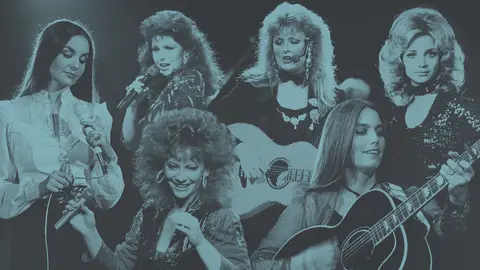Women's History Month: The Shifting Landscape of the '70s and '80s

Just say their names and you instantly hear their voices: Crystal Gayle, the Judds, Reba McEntire, Emmylou Harris, Barbara Mandrell. Musical Amazons all.
The 1970s and '80s resounded with the sounds of new and distinctively individual female artists, few of whom focused on such traditional country themes as mother and home, the comforts of family or the pains of separation from rural or small-town life. Theirs was a wider, more complex world. Before singling them out for their particular achievements, though, it's important to note that these women reached artistic maturity while adjusting to a musical landscape that was rapidly changing and becoming more culturally homogenized.
By the mid-1970s, “outsiders” were making major inroads into country music, with Australian singer Olivia Newton-John winning the CMA female vocalist of the year trophy in 1974. Then, in 1976, the “outlaw” movement in country music was born with the release of the RCA album Wanted: The Outlaws. One of those vinyl-powered outlaws, of course, was a woman -- Jessi Colter. The project became the first country album to reach platinum status, with a million copies sold.
A seismic shift occurred in March 1983 when CMT: Country Music Television and TNN: The Nashville Network debuted just one day apart. Both were created, at least in part, to accommodate the latest in music marketing tools: the music video, which had recently done so much to boost pop music sales. With the advent of music videos, an artist's physical appearance became a factor in who might or might not make it on records.
Below, read about the women who thrived in country music during the 1970s and 1980s:
She may have entered the business as Loretta Lynn's kid sister, but it was evident from her first turn on the charts in 1970 with “I've Cried (The Blues Right Out of My Eyes)” that Crystal Gayle had her own voice. And what a voice it was -- cool, jazzy and more of the supper club than the honky-tonk. Under the elegant production of Allen Reynolds, Gayle pumped out a string of chart-toppers, including “I’ll Get Over You,” the Grammy-winning “Don't It Make My Brown Eyes Blue,” “Ready for the Times to Get Better,” “Talking in Your Sleep” and “Straight to the Heart” -- a total of 18 No. 1s. She was twice voted CMA's female vocalist of the year.
“Delta Dawn” is a Southern Gothic tale about a jilted woman who goes off the deep end—although to a lesser degree than the protagonist in William Faulkner's “A Rose for Emily.” So what the hell was a 13-year-old girl doing singing about such grim matters? Well, when the 13-year-old was Tanya Tucker, the answer was she was doing very well. From the start, and with producer Billy Sherrill's genius for matching material to voices, Tucker sang above her age level (and certainly beyond her experience level). She continued in this dark vein with “What's Your Mama's Name,” “Would You Lay With Me in a Field of Stone,” “Blood Red and Going Down” and “Lizzie and the Rainman.”
With her TNT album and its come-hither cover in 1978, Tucker swapped her wise-child image for a wild-child one. Even so, her chart presence dimmed. Between 1976, when she topped the rankings with “Here's Some Love,” and 1986, when she returned there with “Just Another Love,” she had only three Top 5s. But the late 1980s and '90s saw her register three more No. 1s and 15 Top 5s. After that, her recording lull ended triumphantly in 2020 when her album, While I'm Livin', won her two Grammys.
Converted to country music by her mentor and singing partner Gram Parsons, former folksinger Emmylou Harris entered the country charts in 1975 with “Too Far Gone.” It reached only No. 73, but its follow-up that same year, “If I Could Only Win Your Love,” a Louvin Brothers cover, soared to No. 4. Harris was instrumental in reviving interest in the Louvin Brothers' catalog, and many of her early hits were covers of songs made famous by other artists, including Buck Owens' “Together Again,” Don Gibson's “Sweet Dreams” and Chuck Berry's “(You Never Can Tell) C'est La Vie.”
Harris’ various road and studio bands incubated the talents of such future stars as Rodney Crowell, Vince Gill and Ricky Skaggs, among others. Her angelic voice made her a natural born harmonizer on records with Linda Ronstadt, Dolly Parton, Roy Orbison, John Denver, Earl Thomas Conley, Don Williams and others. She has won a total of 14 Grammys in the country, folk and Americana categories, including a lifetime achievement award in 2018. In 2008, she was inducted into the Country Music Hall of Fame.
Reba McEntire's star was a long time rising, but when it reached its zenith, it shone more brightly than that of any of her female contemporaries. She first charted in 1976 with “I Don't Want to be a One Night Stand,” which barely crawled into the Top 100. It would be six more years before she rose to No. 1, as she did in 1982 with “Can't Even Get the Blues.” But once she got on a roll -- promoted heavily by movie-like music videos -- she tallied up 23 more chart-toppers, including such classics as “Whoever's in New England,” “Little Rock,” “One Promise Too Late” and “The Heart Won't Lie.” She also recorded socially conscious songs like “She Thinks His Name Was John” (about the hazards of unprotected sex), “The Stairs” (domestic abuse), “Just Across the Rio Grande” (the plight of Mexican immigrants) and “The Greatest Man I Never Knew” (emotionally distant parenting).
McEntire further distinguished herself on Broadway with rave reviews for her lead role in Annie Get Your Gun, and in movies (Tremors, North), sitcoms (Reba) and major venue concerts (Madison Square Garden). With her second husband, Narvel Blackstock, she set up Starstruck Enterprises, which embraced recording, music publishing and management, among other artist services. She was inducted into the Country Music Hall of Fame in 2011 and received the Kennedy Center Honors in 2018.
A dazzling multi-instrumentalist, Barbara Mandrell was touring with Patsy Cline and Johnny Cash as a support act by the time she was 14. Based initially in her home state of California, Mandrell moved to Nashville in 1968 after being inspired by a trip to the Grand Ole Opry. She soon signed to Columbia Records and first charted for that label in 1969 with “I've Been Loving You Too Long.” Her first Top 10 solo single came in 1973 with the suggestive “Midnight Oil,” which betrayed Mandrell's penchant for songs with an R&B edge. It wasn't until 1978 and her 26th single that she had a No. 1 -- “Sleeping Single in a Double Bed,” which she immediately followed with another chart champion, “If Loving You Is Wrong I Don't Want to be Right.”
In 1981, by which time she had become a television star via Barbara Mandrell & the Mandrell Sisters, she went No. 1 with the song that would become her signature hit, “I Was Country When Country Wasn't Cool.” Two other No. 1s lay ahead: "'Till You're Gone” and “One of a Kind Pair of Fools,” both in 1983. In 1984, she was seriously injured in a car wreck that killed the other driver. The accident effectively ended her prominence as a recording artist, although she would continue to chart song intermittently until 1989. As an actress, Mandrell appeared in such shows as Touched by an Angel, Empty Nest, Diagnosis Murder, Dr. Quinn Medicine Woman, Baywatch and The Rockford Files. Her autobiography was made in the TV movie, Get to the Heart (The Barbara Mandrell Story). She was welcomed into the Country Music Hall of Fame in 2009.
The Judds -- mother Naomi and daughter Wynonna -- seemed to come out of nowhere. Unlike other acts that arrive after years of club performances and singles on minor labels that never chart, the Judds were virtually stars from the moment they signed to RCA Records in 1983. Blessed with gorgeous melodies, good looks and a gift of gab that endeared them to reporters and TV hosts, the duo went Top 20 with their first single, “Had a Dream (For the Heart),” then saw their next eight releases arc to No. 1. Indeed, their second and third singles, “Mama He's Crazy” and “Why Not Me,” won Grammys.
In time, they would also win Grammys for “Grandpa (Tell Me 'Bout the Good Ole Days),” “Give a Little Love” and “Love Can Build a Bridge,” the latter co-written by Naomi. After contracting a life-threatening illness, Naomi withdrew from touring and performing in 1991, while Wynonna continued on as a solo act. Years later, they teamed up again for occasional shows, but they never again commanded the charts as they had at the outset of their careers.
OTHER HITMAKERS
In 1970, Lynn Anderson scored her first country No. 1, “Rose Garden,” which also went No. 3 pop. In a chart career that extended to 1989, she had four more No. 1s and 12 Top 10s. From 1967 to 1972, she regularly appeared on Lawrence Welk's weekly TV show. Her mother, Liz Anderson, wrote or co-wrote several chart songs for Merle Haggard, including “The Fugitive.”
Future “outlaw” Jessi Colter first entered the country charts in 1970 with “Suspicious Minds,” a duet her husband, Waylon Jennings, But her biggest hit and only No. 1 was the haunting “I'm Not Lisa” in 1975. She went No. 5 that same year with “What's Happened to Blue Eyes.”
Donna Fargo had much of America singing along with her in 1972 with her insanely peppy “The Happiest Girl in the Whole U.S.A.,” which copped a Grammy. Five more of her generally sunny singles also reached the top, including “Funny Face,” “Superman” and “That Was Yesterday,” Fargo was diagnosed with multiple sclerosis in 1979 but continued to record into the 1990s.
Canadian singer Anne Murray is also in country's Class of 1970. That year, she made her country and pop debut simultaneously with “Snowbird.” Although she would continue to chart pop, her greatest successes were in country, where, between her breakthrough and 1986, she racked up 10 No. 1s. Among these were “He Thinks I Still Care,” “I Just Fall in Love Again,” the Grammy-winning “Could I Have This Dance” (from Urban Cowboy), “A Little Good News” and “Just Another Woman in Love.”
Linda Ronstadt has a solid country pedigree quite apart from her trio recordings with Emmylou Harris and Dolly Parton. Her first country single was “Silver Threads and Golden Needles” in 1974. Her cover of Hank Williams' “I Can't Help It if I'm Still in Love With You” hit No. 2 that same year and won her a Grammy. In her 26 charted singles between 1974 and 1995, she had two No. 1s and nine Top 10s. Trio, Ronstadt's 1987 co-op with Parton and Harris, was the No. 1 country album for five weeks and won a best vocal performance Grammy.
Singer Helen Cornelius teamed up with veteran performer Jim Ed Brown in 1976 to create some of the most popular duet recordings and shows of the decade. Their first single, ”I Don't Want to Have to Marry You,” went No. 1 and over the next five years, they charted 12 more songs, including “Saying Hello, Saying I Love You, Saying Goodbye,” “If the World Ran Out of Love Tonight,” “Lying in Love With You,” “Fools” and Morning Comes Too Early.”
Flourishing on the country charts from 1978 until 1989, Juice Newton took four songs to the top: ”The Sweetest Thing (I've Ever Known)” (1981), “You Make Me Want to Make You Mine” and “Hurt” (both 1985) and “Both to Each Other,” a duet with Eddie Rabbitt (1986).
It was as a background and jingle singer that Janie Fricke first dipped her toes into country waters. Her first single, “What're You Doing Tonight,” reached No. 21 in 1977, and her first No. 1, “On My Knees,” was a 1978 duet with Charlie Rich. In the early '80s, she scored seven solo No. 1s, including “It Ain't Easy Being Easy,” “Tell Me a Lie” and “Your Heart's Not in It.” She won the CMA female vocalist of the year award in 1982 and '83.
Gail Davies holds the honor of being the first woman on a major country music label to produce and arrange her own albums. Like Emmylou Harris, Davies has demonstrated a great respect for the music of early country artists, covering such fare as Johnnie & Jack's 1951 hit, “Poison Love,” Carl Smith's “It's a Lovely, Lovely World” from 1952 and Webb Pierce's “No Love Have I” from 1959. In 2002, Davies produced the all-star tribute album to Pierce, Caught in the Webb.
Lacy J. Dalton flourished as a hitmaker from 1979 to 1990 but is best known for her 1982 anthem for Music Row songwriters, “16th Avenue.
Rosanne Cash clocked in her first No. 1 single, the self-written “Seven Year Ache,” in 1981. It would be the first of 11 such smashes, most having to do with relationships gone wrong, including such memorables as “I Don't Know Why You Don't Want Me” (which won a Grammy) and “The Way We Make a Broken Heart.”
Like Cash, Sylvia began making her mark as a recording artists in the early '80s, with chart-toppers like “Drifter” and “Nobody.” She continued to turn out Top 5 and Top 10 hits for RCA until 1985 and remains an active and beloved performer.
Deborah Allen, who was Sylvia's contemporary and labelmate, scored her first three hits singing harmony to tracks by Jim Reeves, who had been killed in a plane crash when Allen was 11. She soon demonstrated, though, that she had a strong, sultry voice of her own with Top 5 hits like “Baby I Lied” and “I've Been Wrong Before.”
The four Forester Sisters brought a breath of fresh air to country music between 1985 and 1992 via such No. 1s as “I Fell in Love Again Last Night,” “Just in Case” and “Mama's Never Seen Those Eyes.”
First drawing attention to herself in 1986 with her Top 10 hit, “Daddy's Hands,” Holly Dunn was as formidable a songwriter as she was a singer. Of the 21 songs she charted between 1985 and 1995, including the No. 1s “Are You Ever Gonna Love Me” and “You Really Had Me Going,” she wrote or co-wrote 13. Inducted by the Grand Ole Opry in 1989, Dunn died in 2016 at the age of 59.
Formed in California, the high-spirited Highway 101 was fronted by the marvelous Paulette Carlson, So great was the band's impact that the CMA proclaimed it vocal group of the year in both 1989 and 1990, impressed by such hits as “Somewhere Tonight,” “Cry, Cry, Cry,” “(Do You Love Me) Just Say Yes” and “Who's Lonely Now.”
Although she first charted in 1981, the irrepressible K.T. Oslin didn't really hit her stride until 1987, by which time she was 45 years old. The vehicle for her arrival was “80's Ladies,” a song she wrote and which became a theme and rallying cry for a whole generation of women. It peaked at No. 7 but, nonetheless, earned her a Grammy. In 1988, she won the best female vocalist award from the CMA. Oslin made good use of music videos, stringing them together into a continuing narrative with her singles serving as soundtracks. Her 1988 No. 1, “Hold Me,” won Grammys for both song and vocals. Her other chart crowns were “Do Ya,” “I'll Always Come Back” and “Come Next Monday.”
Kathy Mattea will probably always be most fondly remembered for her majestic and tear-inducing 1989 single, “Where've You Been,” which, while ascending only to No. 10, earned her two Grammys. Originally a bluegrass singer, Mattea came to Nashville and embraced country in the early 1980s. Like Crystal Gayle, Mattea was produced by the hitmaking Allen Reynolds. Among Mattea's other singles that have since become standards are the No. 1s “Going Gone,” “Eighteen Wheels and a Dozen Roses,” “Come From the Heart and “Burnin' Old Memories.” She was voted the CMA's top female vocalist in 1989 and 1990 and won another Grammy for her 1993 album Good News.
Three years into a rich career that would see her chart a total of 44 singles, Patty Loveless earned her first Top 10 in 1988 with “If My Heart Had Windows,” originally a 1967 hit for George Jones. Loveless has always been a country traditionalist, providing her often mournful, bluegrassy vocals to artists as disparate as Vince Gill and Ralph Stanley. She joined the Opry in 1988, then landed her first No. 1 in 1989 with “Timber, I'm Falling in Love.” Yet, greater commercial fortunes, and multiple CMA and Grammy awards awaited.
The contributions of female recording artists and songwriters -- including many of the women on this list -- would continue through the 1990s and into the first two decades of the 2000s. Read about the first generation of female country artists and the greatest female country stars of the 1950s and 1960s.
Pictured above: Crystal Gayle, the Judds, Reba McEntire, Emmylou Harris, Barbara Mandrell





